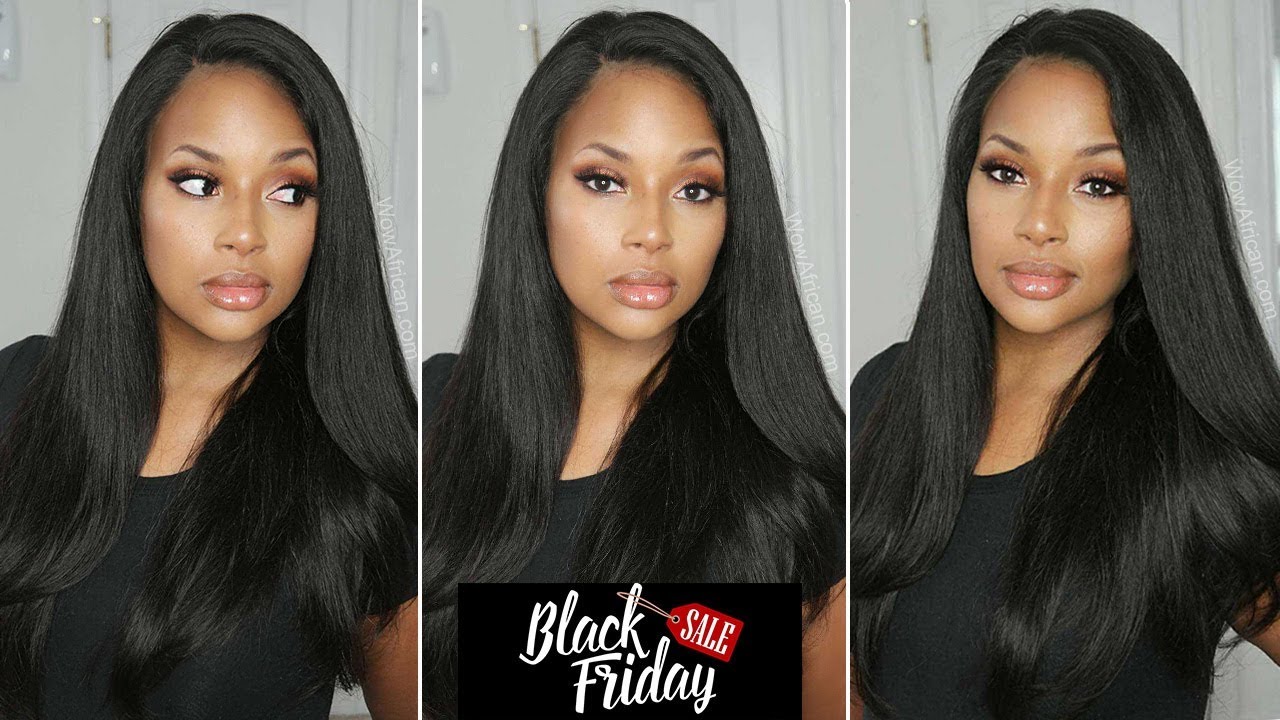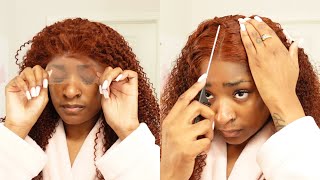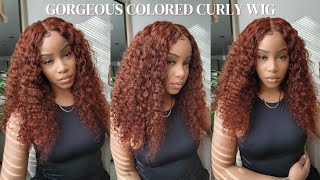Wrap Dry Blow Dry (Straight And Sleek)
- Posted on 24 April, 2018
- Short Hair
- By Anonymous
If you have a hard time getting your hair straight with a round brush, is video is for you. This is my go to blow dry technique.
Today, you're seeing my naturally air-dried curly hair in all of its form, and today I'm gon na show you how I blow-dry my hair, really nice and smooth it's known as a wrap dry and I'm gon na be using a flat brush a flat brush is a Little different than a round brush where I'm going to be utilizing the round or the curve of my head to create a nice smooth blow-dry. So I'm gon na go get my hair washed and shampooed and I'll be right back. So, let's get started. I'Ve got my hair freshly washed it's in a towel and the first step that I'm going to do I'm looking a little bit crazy for you all. Is I'm going to properly comb my hair out now you could use a comb like I'm going to or you could even use a comb out brush like I've mentioned before, and I like to typically always start on one side so that that way, I'm not really Tugging my hair too much because, depending on your hair type, it's in a very fragile state when your hair is wet and if we tug on our hair too much, it might cause breakage. And, given that I color my hair, it is a little bit more fragile than someone that doesn't and my hair type is fine, so baby skinny little trees and then my density is about medium added, shampoo and condition. When I conditioned my hair because I want to have a smooth look, I even applied my conditioner a little bit more to sort of the top of my head, but not right onto my root. So now that that's all combed out, I want to apply a little bit of product today, I'm gon na use smooth infusion, which is a product. That'S going to help protect my hair against humidity. It'S also going to help smooth down the cuticle of my hair and it's important that when you're taking product that you evenly distribute it and keep in mind that you have double the amount of hair at the back of your head, then you do at the top. So I'm gon na apply my product starting from the back and then I'm gon na work it through the ends and mid-lengths and then with the very trace elements on my hands. I'M gon na use that, at the top with this smooth, sleek blow-dry also known as a wrap, dry or a flat wrap. It isn't really important that I know where my parting is, because I'm going to be directing the hair back and forth and then I'll finally be placing the parting in my hair. So I do have a little bit of parting here right now. I'M just gon na remove that my choice of brush from my blow-dried today is a vest brush. It'S going to help guide the hair across my head and because it has pretty good tension, it's going to help grip that hair. As I'm doing that motion a paddle brush for me, I have a small head and with a paddle brush, I feel like I don't get enough tension on my hair. If I was to use a dressing brush like a Mason Pearson, I might find that I have too much tension and it's going to compromise my hair type, I'm not going to use a round brush a round brush is utilizing the brush to form a shape. I just need a tool: that's going to glide the hair over my head because it's my head: that's going to create a shape, so I've got my blow-dryer ready, I'm using a nozzle to help direct the hair and let's get started. So what I'm doing here is I'm blow-drying, my hair forward against the curvature of my head. Everything is going in one direction towards my face and I'm coming all the way from the back all the way to the front, hairline and working that one panel as I'm blow-drying and my blow-dryer is really staying stationary and it's the brush. That'S directing the hair as to where I'm going as I come along the back, I'm changing directions which is okay, because the concept is still the same where I'm directing the hair around my head. When I blow-dry bend down it's because if I go too far to one side, it'll actually create a curve in my hair. So I'm going across and then down across and then down the other thing that I'm doing is I'm looking down and when I look down it utilizes the curve at the bend of your neck. And if you look up your hair will actually kick out. So that is very important to be looking down. So it's usually at about this point that my arms get tired. So I switch it up and I alternate the hand that I'm holding the blow-dryer and brush with and then I do the exact same thing on the opposite side and blow-drying in the same manner. So going forward from back to my face or to the front using the round of my head, which is actually called your parietal Ridge and then doing the same movement that I did on the opposite side. So blow-drying my hair towards the center of my head and carrying it all the way around to my crown, so where a lot of people have growth pattern by working back and forth there, it is gon na make it lay flatter and I'm working seamlessly across. So there's no stopping or starting point, then my arms get tired again, but that's ok, because I'm gon na go now to the top of my head. So when I'm doing the top of my head and you'll see, some of my curl is coming out there. So I know that I need to focus in on this area, but when I go to do the top, I want to utilize the curve of my forehead. So what you're gon na notice is? I'M gon na lift my chin and I'm gon na blow-dry going one direction and then I'm gon na flip it around what that does is it causes the hair to get confused and just lay flat. So let me show you and for the top of my head, you can even see that sometimes it's not the blow-dryer. I move it's my head, which is totally fine and if it's easier for you, you can hold the blow-dryer more stationary and move your head into the position of where you want to have that area dry and I'm wrapping the hair all the way across working from My crown all the way to the top of my forehead and I like to keep my eyes closed. That way, I don't have to worry about getting hair right in my eyes, switching directions. My arms also tend to fatigue on the side that I hold the blow-dryer. So when I switch arms, it means that one arm that gets tired, the other ones gon na be fine, and by working back and forward the hair is gon na, be confused I'll, be able to part it on either side and it won't matter blow-drying. The hair back again giving it another direction of where it's gon na get confused and just lay flat, and then I'm just repeating. I'M going back and forth across horizontally, then combing. The hair back really focusing trying to remove any sort of wet spots but again focusing on the root, I'm not necessarily overly concerned about, what's happening in the mid length and ends, because that I know I can get straight with my flat iron. So this is where a lot of people would stop their blow-dry, and unfortunately this is when you're gon na get a lot of kinking in your hair. If it's not completely dry, so I recommend just to go around and feel all over if you feel any sort of damp spots, because if you do those damp spots are going to be the areas that are gon na frizz up. So I can feel a little bit of moisture still in the back and the tiniest little bit in this area here this area, because it doesn't wrap dry against my head super tight, I'm gon na be better off leafing my hair. What that means is I'm actually gon na place the hair on top of the brush and use the tension of the brush to smooth that area out. So I just use this in spots. I don't do it all over, because it's uncomfortable it's more like round brushing. I'M also being careful when I'm rap, when I'm leafing, I'm not lifting the root area up at the top, because if I was to do this, I'm gon na get volume, and I don't want that. Look today. So far I haven't used a round brush. I'Ve just gone in, and I've leaved, some sections that I needed a little bit smoother but where I focused was to get the root really nice and flat, especially the areas of the head, where my length isn't long enough to work on top of a brush. So, for example, in the back, because my hair is so short if I was to leaf it over. I might create this hair here to stick up and I don't want that once I've gotten my hair to this smoothness, I like to refine it by using a flat iron. I don't use my temperature on my flat iron from my hair type above 360. If I go above that, it'll be too hot and I might create permanent damage to my hair. I'D recommend at home make sure you have a comb, and you also use some clips when I'm clipping my hair you'll notice that when I clip it out of the way I clip the remaining hair against the round of my head. If I don't do that and I clip the hair like so what will happen is my body heat will, set this area and I'll just end up, getting brute lift where I don't want it so make sure that you are being conscious of how you're moving your Hair out of the way before you Flatiron the other thing that I do when I Flatiron hair, which I would recommend at home, is I like to use the small teeth of my comb and I'll insert the comb and I'll connect it to my Flatiron. So they become like one tool: section size really depends on how much time I have in the morning. If you saw me every day, you would see that my hair might not look as nice as I'm about to show you because, let's face it, we're all just people right. So I'm trying not to pick up the previous section, because if I do again it's gon na be a lot of heat and when I'm gliding the Flatiron over my hair, I'm trying my best to not create hot spots. So hot spot would be where you leave. Your Flatiron and you create a marker, so you can see as I go through towards the back of my head, my hand, position changes and I have to kind of do this border line by feel. But if the back of your head doesn't look as good people, don't look there anyway and then the last section along the top for the opposite side, because I wear my hair on this side and there's more hair. I like to clip the top out of the way, then I subsection or I take smaller sections, and I do the same thing on this side that I did to the other. So really my Flatiron and my comb become like one tool and I don't have to worry about burning my fingers because my comb is holding the hair for me as I work up the top. I like to take my sections this way and in order for this area to lay flat, once again, I'm gon na kind of lift my chin and I'm gon na pull so that when that hair falls and cools, it's gon na fall on the curve of my Forehead then, I like to take just the last section right along the top, where my parting is and I'll just kind of Bend the root area so that it'll follow the round of my head and I'll. Take that down I'll, give it a once-over, and you can see in the back here that it's still a little bit puffy so I'll, just section that off and trying to keep my sections as clean as possible, so that I don't repeat any of the same areas. If your hair is longer what's nice, when you go to do the top, is you can really kind of just lift the mid-length and then pull the hair towards the front again, because my hair is pretty short, I have to keep my arms at the back, but If you have long hair, take them at the back and then slide forward, take it at the back and slide forward so from here. My last step is I like to take a smoothing product or something that's gon na make my hair, nice and shiny, and with this shine product I don't apply it right to the top of my head. I always start at the back and then what's left over at the very end I applied to the front and there's the finished. Look. Let me know how it goes when you tried these techniques at home, you





Comments
Sara Edda: My 'No Nonsense" hairdresser mother does this but she has never articulated it like you have! Thank you - I was able to rock a beautiful sleek look today !!!!
Shawna Faulk: Thank you so much for this video! I have watched my hairdresser style my hair this way, but have never been able to replicate it well. Your video is easy to follow and helped me to understand the purpose of drying it this way. I was able to get my wiry gray hair to look sleek and smooth on the first try!
Brittany Hul: Thank you! This was really helpful, I have always used a round brush when blow drying but recently cut my hair very short (a little longer than yours in this video) and did not like the way that looked. This worked really well for me. Thanks!
Miriam Christoph: The Morgan Roy -patented blow-dry! This was the first styling technique you taught me back when we were teenagers.
Mary-Ann Roy: You’re so good at explaining things. Thank you!
DMS: This is an excellent video with super helpful tips!!! I think I always make the mistake of stopping before my hair is fully dry. Would it be easier and healthier for the hair to do a keratin straightening treatment vs. using a flat iron each time we style our hair? Thanks so much!
malu venugopal: I love short haircuts and styling it. Awesome presentation, this video is really helpful. Thank you Morgan and wish you Good luck
Shelia Smith: Love your natural curls.
jhopq: I never learned about this technique before: confusing the hair. Thanks for the info this is very helpful because i do have natural waves and i can't seem to get rid of them properly when i blow dry and i do have a short bob.
Hiba Sobh: I think her curly hair looks super cute on her!
Liberty Jay: Beautiful!
marbetka k: Very informative video, ty what is the name of this brush for blow-drying?
Maham Zahid: Would this be a good idea for longer hair as well?
ddmc 1973: What about thick hair, does this still work?
Michelle Elam: Can you list the brush you used?
Sabreen Mahmud: You have beautiful dry short blonde hair!
Leah Frizzell: Thank you!
Amrita Sodhi: What’s the brush called- thanks
Lalala: I love your curly hair
Alexia Kan: My hair is short but definitely not fine and quite curly and thick,would you achieve the same hairstyle by blow drying it for longer,more flat ironing,or is there some other technique I could use that would maybe cause less damage to my hair? xxx